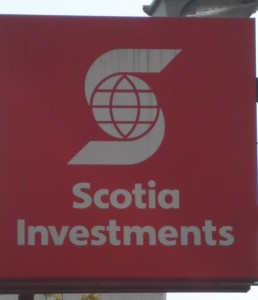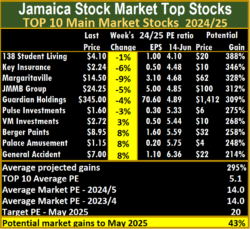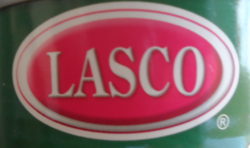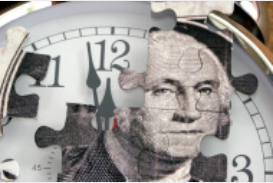 The Jamaican dollar gave back 9 cents of its value as measured by the average selling rate for the United States dollar on Thursday as net inflows into the Jamaican foreign exchange market declined on Thursday from the net position on Wednesday.
The Jamaican dollar gave back 9 cents of its value as measured by the average selling rate for the United States dollar on Thursday as net inflows into the Jamaican foreign exchange market declined on Thursday from the net position on Wednesday.
At the close, the United States currency was being sold at an average of J$128.38, co0mpared to J$128.30 on Wednesday. Dealers bought the US currency at an average of J$127.55, up slightly from JS$127.53 previously. Dealers bought the equivalent of US$8 million more funds than they sold, up from US$15 million on the prior trading day, bringing the surplus for the week to US$44.5 million.
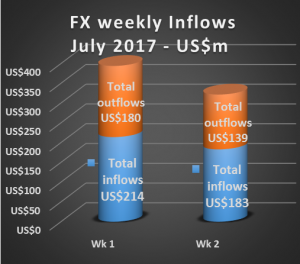 Dealers purchased US$37 million and sold US$29 million, of all currencies on Thursday. On Wednesday, US$47.87 million entered the market and US$32.54 million was sold to the public.
Dealers purchased US$37 million and sold US$29 million, of all currencies on Thursday. On Wednesday, US$47.87 million entered the market and US$32.54 million was sold to the public.
In USA dollar trading, inflows into the system ended at US$35 million versus US$41.3 million previously, while selling amounted to US$28 million versus US$27.9 million on Wednesday.
The selling rate for the Canadian dollar rose to J$101.12 from J$100.04 at the close on Wednesday, while the British Pound was more costly at the close on Thursday, with J$166.91 buying the British currency versus J$164.23 on Wednesday and the Jamaican dollar fell in value against the euro, with it taking J$147.14 to buy the European common currency on Thursday, versus Wednesday’s rate of J$146.28.
Jamaican$ gains as net inflows rise – Wednesday
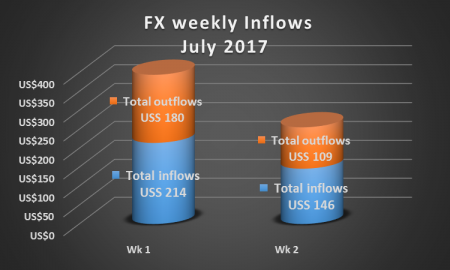 A net increased inflows of foreign currency entered the Jamaican foreign exchange market on Wednesday, leading to the value of the Jamaican dollar gaining 9 cents against the United States dollar. At the close, the United States currency was being sold at an average of J$128.30, down from J$128.39 on Tuesday.
A net increased inflows of foreign currency entered the Jamaican foreign exchange market on Wednesday, leading to the value of the Jamaican dollar gaining 9 cents against the United States dollar. At the close, the United States currency was being sold at an average of J$128.30, down from J$128.39 on Tuesday.
In Wednesday’s trading on foreign currency market dealers bought the US currency at an average of J$127.53, up slightly from JS$127.52 previously. Dealers bought the equivalent of US$15 million more funds than they sold, up from US$8 million on the prior trading day bring the surplus for the week to US$37 million.
Dealers purchased US$47.87 million and sold US$32.54 million, of all currencies on Wednesday. On Tuesday, US$47.77 million entered the market and US$39.4 million was sold to the public.
In USA dollar trading, inflows into the system ended at US$41.3 million versus US$42.4 million on Tuesday, while selling amounted to US$27.9 million versus US$33.2 million on Tuesday.
The selling rate for the Canadian dollar rose to J$100.04 from J$99.73 at the close on Tuesday, while the British Pound cost less at the close on Wednesday, with J$164.23 buying the British currency versus J$165.86 on Tuesday and the Jamaican dollar jumped in value against the euro, with it taking J$146.28 to buy the European common currency on Wednesday versus Tuesday’s rate of J$149.03.
Jamaican dollar value slips – Tuesday
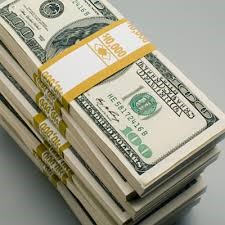 The value of the Jamaican dollar slipped by 2 cents against the United States dollar rising to J$128.39 from J$128.37 on Monday. Dealers bought the US currency at J$127.52 up from JS$127.49 previously.
The value of the Jamaican dollar slipped by 2 cents against the United States dollar rising to J$128.39 from J$128.37 on Monday. Dealers bought the US currency at J$127.52 up from JS$127.49 previously.
On Tuesday’s trading in Jamaica’s foreign currency market saw the equivalent of US$8 million more funds coming into the system than left, down from US$13 million on the prior trading day bring the surplus for the week to US$21.4.
Dealers purchased US$47.8 million and sold US$39.4 million, of all currencies on Tuesday. On Monday, US$50.44 million entered the market and US$37.4 million was sold to the public.
In USA dollar trading, inflows into the system ended at US$42.4 million versus US$46.3 million on Monday while selling amounted to US$33.2 million versus US$34.8 million on Monday.
The selling rate for the Canadian dollar fell to J$99.73 from J$99.98 at the close on Monday, while the British Pound cost more at the close on Tuesday, with J$165.86 buying the British currency versus J$163.85 on Monday and the Jamaican dollar fell in value against the euro, with it taking J$149.03 to buy the European common currency on Tuesday versus Monday’s rate of J$146.69.
More gains for Jamaican dollar – Monday
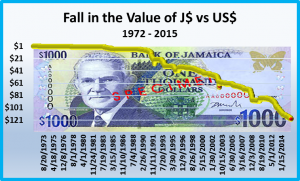 Dealers in Jamaica’s foreign currency market saw the equivalent of US$13 million more funds coming into the system than left, helping to drive the value of Jamaican dollar further upwards with the selling rates of the United States dollar dropping to J$128.37, down from J$128.43 on Friday.
Dealers in Jamaica’s foreign currency market saw the equivalent of US$13 million more funds coming into the system than left, helping to drive the value of Jamaican dollar further upwards with the selling rates of the United States dollar dropping to J$128.37, down from J$128.43 on Friday.
Dealers bought the United States dollar at J$127.49 up from JS$127.41 previously.
The positive net inflows on Monday continue the trend set for the prior week with surplus inflows on each day.
Dealers purchased US$50.44 million and sold US$37.4 million, of all currencies on Monday. On Friday, inflows into the market generated US$36.2 million in all currencies, while US$30.2 million was sold to the public.
In USA dollar trading, inflows into the system ended at US$46.3 million versus US$32.3 million on Friday while selling amounted to US$34.8 million versus US$27 million on Friday.
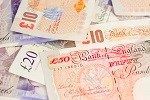 The selling rate for the Canadian dollar rose to J$99.98 compared to J$99.79 at the close on Friday, while the British Pound cost less at the close on Monday, with J$163.85 buying the British currency versus J$165.19 on Friday and the Jamaican dollar gained value against the euro, with it taking J$146.69 to buy the European common currency on Monday versus Friday’s rate of J$148.09.
The selling rate for the Canadian dollar rose to J$99.98 compared to J$99.79 at the close on Friday, while the British Pound cost less at the close on Monday, with J$163.85 buying the British currency versus J$165.19 on Friday and the Jamaican dollar gained value against the euro, with it taking J$146.69 to buy the European common currency on Monday versus Friday’s rate of J$148.09.
J$ lose in FX trading – Thursday
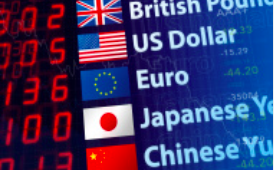 Inflows of foreign exchange for the week to Thursday netted US dollar equivalent of $28 million while in United States currency, the surplus is US$24.5 million. Dealers bought the US dollar from a high of J$127.81 to a low of J$127.02, the average selling rate only moved between J$128.50 to $128.44 for the week so far.
Inflows of foreign exchange for the week to Thursday netted US dollar equivalent of $28 million while in United States currency, the surplus is US$24.5 million. Dealers bought the US dollar from a high of J$127.81 to a low of J$127.02, the average selling rate only moved between J$128.50 to $128.44 for the week so far.
On Thursday, dealers sold the US dollar for an average which was 1 cent higher than on Wednesday, to close at $$128.45, only the second day the rate moved up, in more than a month. On Thursday, US$44.3 million entered the market with US$38.9 million leaving, of all currencies. On Wednesday, inflows into the market generated just US$58.7 million in all currencies, while US$42.25 million was sold to the public.
At the close, the Jamaican dollar value slipped, with the selling rate of J$128.45 for one US dollar, down from J$128.44 it ended at on Wednesday. Dealers bought the United States dollar at J$127.49 down from JS$127.81 previously.
In USA dollar trading, inflows into the system ended at US$30.9 million versus US$46.87 million on Wednesday while selling amounted to only US$25.4 million compared to US$34.3 million on Wednesday.
The selling rate for the Canadian dollar climbed to J$99.63 compared to J$99.37 at the close on Wednesday, while the British Pound cost more at the close on Thursday with J$166.06 buying the British currency versus J$165.94 on Wednesday and the Jamaican dollar lost value against the euro, with it taking J$150.78 to buy the European common currency on Thursday versus Wednesday’s rate of J$147.8.
Big increase in FX trading – Wednesday
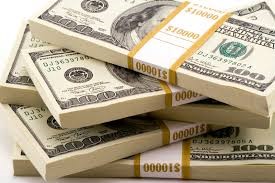 Trading levels, picked up sharply from the low levels on Tuesday, with US$58.7 million entering the market and US$42.25 million leaving. On Tuesday, inflows into the market generated just US$23.84 million in all currencies while US$22.52 million was sold to the public.
Trading levels, picked up sharply from the low levels on Tuesday, with US$58.7 million entering the market and US$42.25 million leaving. On Tuesday, inflows into the market generated just US$23.84 million in all currencies while US$22.52 million was sold to the public.
At the close of the market on Wednesday, the Jamaican dollar recorded moderate gains, with the selling rate of J$128.44 for one US dollar, down from J$128.46 it ended at on Tuesday. Dealers bought the United States dollar at J$127.81 up from JS$127.02.
In USA dollar trading, inflows into the system ended at US$46.87 million versus US$21.54 million on Tuesday while selling amounted to only US$34.3 million compared to US$20.36 million on Tuesday.
The selling rate for the Canadian dollar inched up to J$99.37 compared to J$98.01 at the close on Tuesday, while the British Pound cost less at the close on Wednesday with J$165.94 buying the British currency versus J$166.91 on Tuesday and the Jamaican dollar lost value against the euro, with it taking J$147.8 to buy the European common currency on Wednesday versus Tuesday’s rate of J$145.42.
Radio Jamaica looks promising
 Radio Jamaica generated revenues of $1.2 billion in the March 2017 quarter, $156 million less than the December quarter but had $49 million more in direct expenses in the March quarter when it was expected that direct expenses would have fallen in keeping with the reduced income.
Radio Jamaica generated revenues of $1.2 billion in the March 2017 quarter, $156 million less than the December quarter but had $49 million more in direct expenses in the March quarter when it was expected that direct expenses would have fallen in keeping with the reduced income.
The group also reported lower profits in the March quarter compared with the December quarter and suffered a loss before taxation of $30 million and $65 million after an increased taxation charge of $35 million, bringing the full year taxation provision to $75 million. RJR ended the fiscal year with profit after tax of $145 million or just 6 cents per share. Results for 2018 should be much better as staff cost will fall with reduction in staffing while some one off cost that affected profit, should not recur.
In the March quarter, general expenses fell by $110 million from the December quarter to reach $562 million. The sharp change could result from reclassification of some expenses to direct cost, resulting in the jump in this area in the last quarter of the fiscal year. In the December quarterly report, the company stated that “increased cost of $64 million was incurred largely from further operational investments and one- off costs”. The areas that incurred the cost are continued rollout of 1 Spot Media, legal expenses incurred in protecting copy rights and defending legal action and repairs to broadcast transmitters. This was reconfirmed by Managing Director, Gary Allen in response to questions posed by IC Insider.com as the reason why profit in the Television segment had fallen even as revenues rose.
“The figures have seven months of the old structure. Only five months of HR synergies were realised in the financial year under review, as redundancies took place in September/November” Gary Allen, Managing Director advised IC Insider.com, in response to our question of how much staff cost is in the 2107 figures for person who were made redundant?
Prior to the merger investors were advised of major cost reduction and improved revenues that will flow from the merged entity. Allen stated ‘they have started with the HR synergies. Others are being realised as we integrate systems in the operations. Most elements will be implemented by the end of 2018/2019.”
Cash flow from operating activities was $363 million but $248 million was spent on acquiring fixed assets with the group ending with cash and equivalent of $291 million at the end of the year. RJR also has investments in bonds and Government of Jamaica securities amounting to $487 million.

Gleaner & RJR execs signing merger agreement in 2015
The RJR Group underwent major changes with the acquisition of the Gleaner media business. Comparing the 2017 fiscal year’s results with that of 2016 makes little sense with the latter having very little financial data of the acquired business.
Data contained in the segment results, provide some indication as to the performance of various parts of the group. The performance of the segments in 2017 over 2016 show, Audio Visual generating just $65 million more in revenues in 2017 to end with $1.868 billion and contributed $72 million to profits compared to $157 million in 2016, Audio comprising radio operations had revenues of $711 million compared to $567 million and contributed profit of $238 million versus $112 million, Independent Radio coming on stream and growth in Outside Broadcasts contributed to the increase. The print division showed revenues of only $78 million in 2016 and a loss of $190 million saw a major about turn, with revenues of $2.8 billion and profit of $173 million for 2017.
Allen went on to state that “the market will remain competitive and the economic conditions of Jamaica will continue to impact media spend. Improvements will come from those able to leverage market leadership positions, product diversification, overseas earnings and new marketing strategies. RJR has all the necessary ingredients to meet these challenges and the opportunities on the horizon.”
The stock traded at $1.60 on the Jamaica Stock Exchange on Friday and with IC Insider.com projecting earnings of 25 cents per share for 2018 fiscal year ending in March, the stock seems attractive coming against a back ground of continued growth in the Jamaican economy.
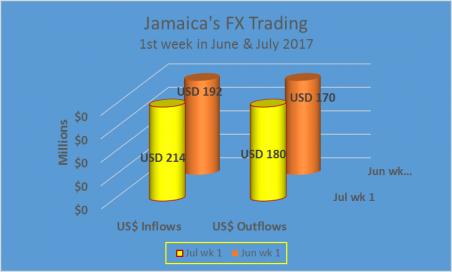 Flows for the US dollar in July, ended with US$177.55 million flowing into the system and $147.7 million flowing out, compared to US$172.14 million and US$158.43 million respectively in June.
Flows for the US dollar in July, ended with US$177.55 million flowing into the system and $147.7 million flowing out, compared to US$172.14 million and US$158.43 million respectively in June.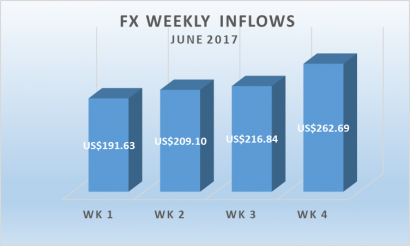 The selling rate for the Canadian dollar rose to J$99.39 compared to J$99.07 at the close on Thursday while the British Pound cost slightly more at the close on Thursday with J$166.58 buying the British currency versus J$165.40 on Thursday and the Jamaican dollar lost value against the euro, with it taking J$147.94 to buy the European common currency on Friday versus Thursday’s J$146.66.
The selling rate for the Canadian dollar rose to J$99.39 compared to J$99.07 at the close on Thursday while the British Pound cost slightly more at the close on Thursday with J$166.58 buying the British currency versus J$165.40 on Thursday and the Jamaican dollar lost value against the euro, with it taking J$147.94 to buy the European common currency on Friday versus Thursday’s J$146.66.